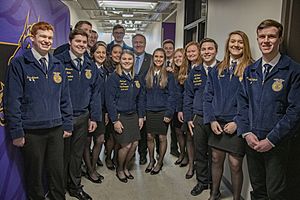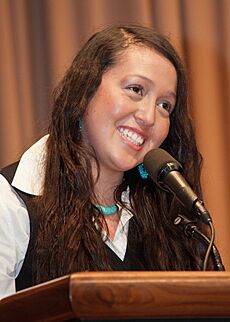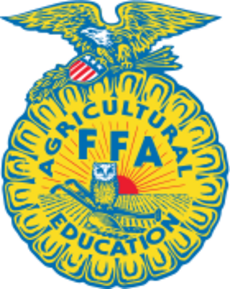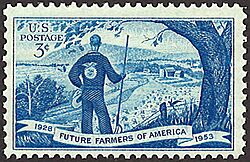National FFA Organization facts for kids
 |
|
| Formation | 1928 |
|---|---|
| Type | Youth organization |
| Legal status | 501(c)(3) nonprofit |
| Headquarters |
|
|
Region served
|
|
|
Membership
|
1,027,273 (9,235 chapters in 50 state associations and 2 territories) |
| Dr. Travis Park | |
| Scott Stump | |
|
National FFA President
|
Thaddeus Bergschneider |
|
|
|
Formerly called
|
Future Farmers of Virginia |
The National FFA Organization, or FFA, is a group in America that helps middle and high school students learn about agriculture (farming) and related jobs. It is a nonprofit organization, meaning it uses its money to support its goals rather than to make a profit.
The idea for FFA started in 1925 with the Future Farmers of Virginia (FFV). This group was founded by agriculture teachers at Virginia Polytechnic Institute. In 1928, it grew into a national organization called Future Farmers of America. This happened at the first National FFA Convention, where groups like FFV from different states came together.
In 1988, the name changed to the National FFA Organization. This change showed that the group is for all students interested in food, natural resources, and related industries. This includes science, business, and technology, not just farming itself. FFA is one of the largest youth groups in the United States. It has over 1 million members in more than 9,200 local groups (called chapters). These chapters are found in all 50 states, Puerto Rico, and the Virgin Islands.
Contents
- What is the National FFA Organization?
- What are Supervised Agricultural Experience Programs?
- What is the Official FFA Dress?
- What Are FFA Traditions?
- How is FFA Organized?
- Who Are the Officers of FFA?
- Important FFA Events and Milestones
- Career & Leadership Development Events (CDE/LDEs)
- Talent Competitions, Band, and Chorus
- Famous People Who Were in FFA
What is the National FFA Organization?
The National FFA Organization is a youth leadership group. It helps young people grow their skills in leadership, personal development, and career success. They do this through education about agriculture. The FFA Motto guides members: "Learning to Do, Doing to Learn, Learning to Live, Living to Serve."
FFA works as part of a three-part system for agricultural education. It is a student leadership group that goes along with classroom learning and hands-on projects. FFA members can join Career Development Events (CDEs). These events test job skills in many areas, from talking to people to understanding machines. Some events are for individuals, while others are for teams. These competitions happen at local, state, and national levels.
Teachers, parents, and other adults help students reach their learning and career goals. The official colors of FFA are national blue and corn gold.
What are Supervised Agricultural Experience Programs?
To be an active FFA member, you must have a Supervised Agricultural Experience (SAE) project. These projects let members use what they learn in agriculture classes in real-life situations. Each state FFA group has rules for SAE projects.
SAE programs are divided into four main types:
- Foundational: This involves learning about the big picture of agriculture and different jobs in the field.
- Research/Experimentation and Analysis: This means doing research or studying information to find new knowledge.
- Ownership/Entrepreneurship: This is about planning and running your own agriculture-related business.
- Placement/Internship: This involves working for pay or experience in an agricultural setting.
What is the Official FFA Dress?


The Famous FFA Jacket
The most well-known symbol of FFA is the blue corduroy jacket. FFA members wear this jacket. On the back, it has a large FFA emblem and the name of the member's state. Below the emblem, the name of the local FFA chapter or area is sewn. The front of the jacket has a smaller FFA emblem on the left side. The member's name, and sometimes their officer role and year, are on the right side. Members can also wear award pins or officer pins under their names. Members must wear the jacket as part of their official dress for all FFA activities.
The FFA jacket was first created in 1933 for a band from the Fredericktown FFA Chapter. The color of the jacket has changed slightly over the years. In 2004, the National FFA Organization worked to make sure the blue corduroy color was always the same. They also improved the embroidered FFA emblems and the jacket's fit.
What Makes Up the Official FFA Dress?
FFA members must wear official FFA dress for official activities. In 2016, the National FFA Organization updated its rules. They stated that members can wear any item they are comfortable in, including items previously meant for only one gender. Religious clothing, like head coverings, is also allowed.
Official dress includes:
- Black pants or a black skirt.
- A white button-up shirt with a collar.
- An official FFA blue scarf (for female members) or tie (for male members).
- Black dress shoes with closed heels and toes.
- Black socks or nylon stockings.
- An official FFA jacket, zipped all the way up.
How Are Awards and Pins Worn?
FFA members earn metal pins for their achievements. These pins can be worn on the front of the FFA jacket. However, rules say that only three pins can be worn at one time. These pins go below the member's name on the right side. They show the highest degree earned, the highest office held, and/or the highest award received, in that order from left to right.
There are two exceptions for pin placement. When a member earns a State FFA Degree or American FFA Degree, these special award keys should be worn above the name on the right side. No other pins should be worn with these keys.
What Are FFA Traditions?
FFA has many traditions and symbols that show it is an agricultural education group:
- The FFA Motto: Learning to Do, Doing to Learn, Earning to Live, Living to Serve.
- The FFA Mission: The National FFA Organization helps students grow their potential for leadership, personal growth, and career success through agricultural education.
- The Official FFA Colors: National Blue and Corn Gold. These colors are seen on the official FFA jackets.
- The FFA Emblem:
- Cross section of the ear of corn: This stands for unity. Corn grows all over the United States, showing that FFA connects members everywhere.
- Rising Sun: This means progress. It reminds members that each day brings new opportunities.
- Plow: This represents hard work and farming the land. It also shows the strong history of our country.
- Eagle: This symbolizes freedom and the chance to explore new ideas in agriculture.
- Owl: This stands for knowledge and wisdom.
- Agriculture Education and FFA: This shows how learning and leadership work together in the organization.
- The FFA Creed:
The FFA Creed is a statement of beliefs written by E.M. Tiffany. It was first used at the 3rd National FFA Convention. It has been updated a few times since then. New members learn and recite the Creed to show their belief in agriculture and agricultural education. You must also memorize and say the FFA Creed to earn the Greenhand Degree.
I believe in the future of agriculture, with a faith born not of words but of deeds – achievements won by the present and past generations of agriculturists; in the promise of better days through better ways, even as the better things we now enjoy have come to us from the struggles of former years.
I believe that to live and work on a good farm or to be engaged in other agricultural pursuits, is pleasant as well as challenging; for I know the joys and discomforts of agricultural life and hold an inborn fondness for those associations which, even in hours of discouragement I cannot deny.
I believe in leadership from ourselves and respect from others. I believe in my own ability to work efficiently and think clearly, with such knowledge and skill as I can secure, and in the ability of progressive agriculturists to serve our own and the public interest in producing and marketing the product of our toil.
I believe in less dependence on begging and more power in bargaining; in the life abundant and enough honest wealth to help make it so-for others as well as myself; in less need for charity and more of it when needed; in being happy myself and playing square with those whose happiness depends upon me.
I believe that American agriculture can and will hold true to the best traditions of our national life and that I can exert an influence in my home and community which will stand solid for my part in that inspiring task.
How is FFA Organized?

FFA is set up in different levels across the country. The main levels are:
- National level: This level serves all of the United States, Puerto Rico, and the U.S. Virgin Islands.
- State level: Each state has its own FFA association.
- Chapter level: This is the local group, usually based at a school or a few schools in an area.
FFA was first for high school students. Now, middle school students can also join, starting as young as 12 years old. This lets members get involved earlier and stay active longer. Each local chapter is part of its state association and the national organization.
Most states have FFA conventions at least once a year. Members go to these events to compete, receive awards, attend leadership workshops, and discuss group issues. The National FFA Convention & Expo happens once a year in the fall. It was held in Kansas City, Missouri, for many years. Then it moved to Louisville, Kentucky, and later to Indianapolis, Indiana. The National Convention is scheduled to be held in Indianapolis until 2033.
Who Are the Officers of FFA?
FFA is led by students. Members elect officers from their own group at different levels of FFA. These officers help run meetings and events using special rules called parliamentary procedure. Each officer has a specific role and a symbol that represents it.
Main Officers
- President: Stands by the rising sun, which means a new start in agriculture. The president leads meetings.
- Vice President: Stands by the plow, a symbol of hard work and farming. The vice president leads meetings when the president is not there.
- Secretary: Stands by the ear of corn. The secretary keeps accurate records of all meetings and communicates with other secretaries.
- Treasurer: Stands by the emblem of George Washington. The treasurer keeps careful records of money, just like Washington did with his farm accounts.
- Reporter: Stands by the flag. The reporter shares information with the public so everyone knows about FFA.
- Sentinel: Stands by the door. The sentinel makes sure everyone feels welcome, takes care of the meeting room, and helps the president keep order.
Other Officer Roles
Some chapters may also have these officers:
- Chaplain: Leads prayers and blessings at events.
- Parliamentarian: Makes sure meetings follow proper rules.
- Historian: Keeps records of past events and maintains a chapter scrapbook.
- Student Advisor: Helps the main advisor and can fill in for other officers if needed.
- Executive Committee/Executive Board: A group of officers who help make decisions.
All officers are agriculture students and have important jobs. Members elect officers each year at their local, state, or national level.
National Officers
At the national level, students hold positions as president, secretary, and vice president for each of the four regions: Eastern, Southern, Central, and Western.
Important FFA Events and Milestones
- 1928: FFA is officially started.
- 1929: National Blue and Corn Gold become the official colors.
- 1930: The Official FFA Creed is adopted.
- 1944: The FFA Foundation is created to raise money for the organization.
- 1950: The U.S. Congress gives FFA a Federal Charter. This means the government officially recognizes FFA as an important part of school agriculture education.
- 1953: The U.S. Postal Service issues an FFA postage stamp.
- 1965: FFA becomes desegregated. It joins with the New Farmers of America organization, which was for students of color.
- 1969: Girls are allowed to become FFA members.
- 1988: The official name changes from Future Farmers of America to National FFA Organization.
- 2006: The National FFA Foundation receives its first $1 million donation from Ford Motor Company.
- 2010: A record 3,449 members earn the American FFA Degree, the highest degree.
- 2011: The National FFA Alumni Association celebrates its 40th anniversary.
- 2015: National FFA celebrates 50 years since the merger of FFA and NFA.
- 2017: Ms. Breanna Holbert from California is elected as the first female African-American National President.
- 2019: FFA celebrates 50 years of female leaders in the organization.
Career & Leadership Development Events (CDE/LDEs)
FFA Career and Leadership Development Events (CDE/LDEs) are competitions where members test skills learned in agriculture classes. These events vary at different FFA levels. Some are only held at certain levels or in specific states.
At the national level, there are 25 CDE/LDEs offered:
- Agricultural Communications
- Agricultural Issues Forum
- Agricultural Sales
- Agricultural Technology & Mechanical System
- Agronomy (study of crops and soils)
- Conduct of Chapter Meetings
- Creed Speaking
- Dairy Cattle Evaluation & Management
- Employment Skills
- Environmental & Natural Resources
- Extemporaneous Public Speaking (speaking without much preparation)
- Farm & Agribusiness Management
- Floriculture (flower growing)
- Food Science & Technology
- Forestry
- Horse Evaluation
- Livestock Evaluation
- Marketing Plan
- Meats Evaluation & Technology
- Milk Quality & Products
- Nursery/Landscape
- Parliamentary Procedure (meeting rules)
- Poultry Evaluation
- Prepared Public Speaking
- Veterinary Science
Some CDE/LDEs offered in certain states but not nationally include:
- Agricultural Mechanics Skills
- Cattle Evaluation
- Tractor driving
- Range Judging
Talent Competitions, Band, and Chorus
Besides the CDE/LDEs, FFA also has a national band and chorus, plus a talent competition. Concert bands have been part of FFA since 1933. The National FFA Chorus and Talent competition started in 1948. Since then, members in these groups have performed at each National FFA Convention. Members who want to join the talent competition, band, or chorus must apply and audition.
Famous People Who Were in FFA
Many well-known people were once FFA members.
In Politics
- Tom Brewer: Nebraska state senator.
- Sam Brownback: Former Governor of Kansas and U.S. Senator.
- Jimmy Carter: 39th President of the United States.
- Rick Perry: Former United States Secretary of Energy and Governor of Texas.
In Entertainment
- Trace Adkins: Country music singer.
- Johnny Cash: Country and rock & roll music singer.
- Chris Colfer: Actor from Glee.
- Steve Doocy: TV personality on Fox News Channel.
- Matthew Fox: Actor from Lost.
- Toby Keith: Country music singer.
- Lyle Lovett: Country music singer.
- Nicolas Cage: Actor.
- Tim McGraw: Country music singer.
- Willie Nelson: Country music singer.
- Taylor Swift: Country and pop music singer.
In the Arts
- Jim Davis: Creator of the Garfield comic strip.
- Jared Hess: Director of Napoleon Dynamite.
Other Notable Alumni
- Josh Allen: Quarterback for the Buffalo Bills (NFL).
- Bo Jackson: Former professional football and baseball player.
- Sterling Marlin: NASCAR driver.
- Ellison Onizuka: American astronaut.
- Carroll Shelby: Automotive designer.



